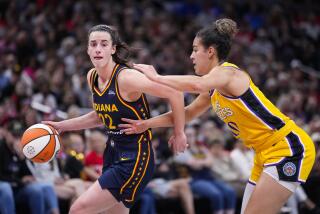They Needed This as Events Unfold
- Share via
AUBURN HILLS, Mich. — Too bad for the Sparks, but their sport needed this more than they did.
After a somber day for women’s sports, with morning newspaper headlines such as “Women’s soccer league fails,” the Detroit Shock held a full-fledged celebration Tuesday night. The Shock was victorious for the second time in as many thrilling games, winning the WNBA championship before a record crowd of 22,076 at the Palace of Auburn Hills. And maybe the Shock propped up a sport in desperate need of help.
The Sparks had a role in this, sure. The presence of the two-time champions gave the Shock an authentic title, not some knockoff imitation.
Now the league is open to everybody. For the first time in the league’s seven years, a team other than the Sparks or Houston Comets won the championship. And that team was the once-lowly Shock, a team that finished last in 2002, playing before home crowds as small as 3,315.
“It’s a great finish to the season,” said NBA Commissioner Val Ackerman, standing on the confetti-covered court. “Very exciting to see the fans of Detroit, after some lean years, respond to what really was an incredible basketball performance.
“To see everybody so excited about their team, to have a great game ... it couldn’t have finished any better for us.”
Even Spark star Lisa Leslie, the most recognizable face in women’s basketball, had to recognize the benefit of the Shock’s 83-78 victory in the deciding third game of the series.
“I have to step out of myself as a Sparks player, but overall as a WNBA player, it has been amazing, the support,” Leslie said.
“This is great for the WNBA, women’s basketball, and hopefully we’ll see those results tomorrow in the paper.”
It would make for much better reading material than Monday’s news that WUSA was folding after three seasons. It tried to ride the wave of excitement generated by the Women’s World Cup soccer tournament in 1999 but was pulled under by a troubled economy and minimal financial support.
The league had the misfortune of starting in April 2001, a year into the stock market slide and five months before the Sept. 11 terrorist attacks. WUSA founder John Hendrick blamed an inability to land sponsors for his league’s demise. It had only two: Hyundai and Johnson & Johnson.
The WNBA has 15 major national marketing partners, including such heavyweights as Anheuser-Busch (Bud Light), Coca-Cola (Dasani Water), Procter & Gamble and General Motors. And it could always lean back on its benefactor, the NBA, which cross-promoted its sister league as much as possible and provided a financial backbone. It also has stars that come pre-packaged from the showcase team event in women’s sports, the NCAA Final Four.
But even with all of its advantages, the WNBA could barely top the ESPN television numbers of WUSA, which drew 0.2% of the TV households. And the average WNBA attendance of 8,830 was not much better than WUSA’s 6,667.
Drive by any grass field on a Saturday and you’ll see young girls out playing soccer. So why didn’t that translate into a successful women’s pro soccer league?
It’s partly because women don’t make good couch potatoes. They’re too busy doing productive things ... including taking their daughters to the soccer match.
“How many women do you know who sit down and watch television on a Saturday afternoon?” said television consultant Neal Pilson, president of Pilson Communications.
“Women are generally not watching television when women’s sports are being presented. Because of that, sponsors don’t find women’s sports to be as efficient as men’s sports.
“If I’m a sponsor, and I want to reach a soccer viewer, I might as well buy men’s soccer.
“Women’s sports are usually 60 [percent] men in terms of who’s watching. That is very inefficient for a sponsor trying to reach women, and it’s inefficient for the sponsor trying to reach men.”
Even the Arena Football League, whose first year on NBC did a 1.1 rating for the network, was a better buy for advertisers.
Even when women are watching sports, they’re generally watching men’s sports. How can women’s sports survive without their own gender rushing to offer support?
It would help to offer copies of Tuesday night’s Game 3. It featured as much action as you could fit beneath the rim: spin moves, no-look passes, flying rebounds and some bad-intentioned elbows. For the second consecutive game, there was a lead change in the final minute. After Leslie missed on a drive that could have tied the score at 75, each team scored on the next five possessions to keep it close. Eleven points in 20 seconds. The final total of 161 points was a WNBA finals record.
“You couldn’t ask for a better game than what you got out there today,” Spark Coach Michael Cooper said.
And you had to be watching ESPN2 to see it on television. The main ESPN was showing the football drama “Playmakers.”
But at least the game was on, unlike the mothballed WUSA. And no, the WNBA can’t expect to gain market share from the WUSA’s demise, Pilson said. The league’s failure could cast doubt in sponsors’ minds and have a chilling effect on all women’s sports.
Perhaps this game could light a match.
Three decades after Title IX, and coming up on two Olympiads since the female-flavored 1996 Games in Atlanta, the WNBA is the best hope for women’s team sports.
“We’re carrying the torch,” said Kedra Holland-Corn, Detroit’s star in Game 2. “Women’s basketball is not concrete, concrete, concrete. But we have another five years and hopefully things will continue to improve, and we’re here forever.”
*
J.A. Adande can be reached at j.a.adande@latimes.com


